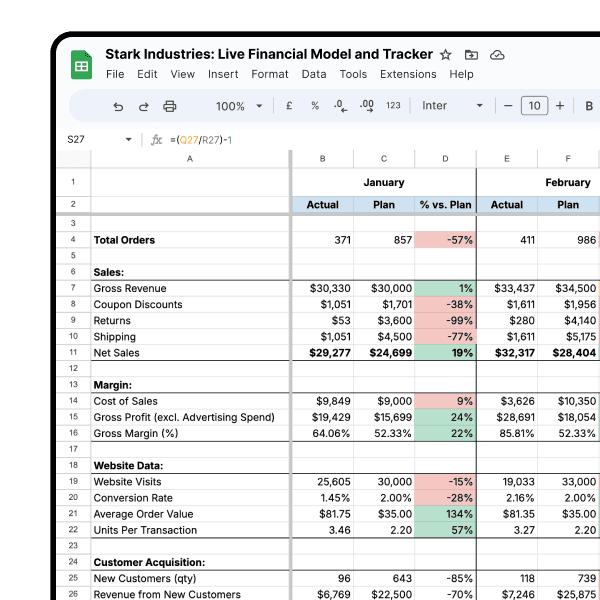Reporting & Analysis
18.01.2024
TLDR
Effective customer segmentation helps brands personalize their acquisition and conversion strategies, allowing them to serve their customers better and keep them coming back for more. Start with identifying the demographic, psychographic, and behavioral patterns that your ideal customers exhibit. Use the free downloadable worksheet to identify 46 parameters on which to segment your potential customers.
Customer segmentation is the practice of dividing a customer base into groups of individuals that share similar characteristics. This process allows businesses to target these groups effectively and allocate marketing resources to the best-suited audience segments.
That’s why brands should call out their core audience on their landing pages (or even home page).

Why is customer segmentation important?
If you’re reading this article you already believe in the important of segments, so I won’t harp on about it (too much). Segmentation is crucial for several reasons. It enables businesses to personalize their approaches, align their products more closely with customer needs and desires, and identify opportunities for new product development. Companies can tailor their marketing strategies, create more personalized experiences, and increase overall customer satisfaction and loyalty.
For instance, a fashion retailer might segment their market into groups like young adults interested in the latest trends, middle-aged professionals looking for business casual attire, and seniors seeking comfort wear.
Three ways to segment customers.
Demographic Segmentation: This process includes categorizing customers based on demographic details such as age, gender, income, occupation, and education level. For instance, a luxury car brand might aim for affluent individuals, while a budget smartphone brand might concentrate on younger, price-conscious consumers.
Psychographic Segmentation: This type of segmentation examines the psychological aspects of consumer behavior, such as values, beliefs, interests, lifestyle, and personality traits. For instance, a travel agency may divide its market into categories such as adventure seekers, luxury travelers, and budget backpackers.
Buying Behavior Segmentation: This approach centers on analyzing customers' purchasing behavior, which includes their buying habits, user status, loyalty, and attitude towards the product. For example, an online bookstore could categorize its customers as frequent buyers, occasional readers, and gift buyers.
So what segments should you look at?
Every brand needs to identify the segments that work best for it. While iOS is making it tougher to preemptively target demographic and psychographic segments, you can always use post-purchases surveys (like from our friends at KnoCommerce) to learn more about the customers who buy from you.
On the other hand, you have very precise control over segmentation based on buying behavior because all the buying happens on your website.
We’ve put together this worksheet of 46 customer segments that you can use to plan your next campaign.
Driving Growth Through Customer Segmentation
Effective customer segmentation leads to:
Enhanced Personalization: Effective customer segmentation allows e-commerce businesses to deliver highly personalized experiences, leading to increased engagement and sales. By understanding the unique needs and preferences of each segment, businesses can deliver personalized customer experiences. Online stores can tailor their product recommendations, marketing messages, and overall shopping experience.
Improved Customer Loyalty: Targeted approaches foster stronger customer connections, significantly boosting loyalty. By addressing the specific desires and expectations of each segment, businesses not only meet but often exceed customer expectations, leading to repeat purchases and positive word-of-mouth. This approach turns occasional buyers into brand advocates and loyal customers.
Increased Marketing ROI: By focusing marketing efforts on specific segments, businesses can achieve a higher return on investment. Segmented marketing campaigns are more likely to reach and resonate with the intended audience, leading to higher conversion rates. This targeted approach reduces marketing waste and ensures that budgets are spent on campaigns that are most likely to yield profitable results.
Download Our Comprehensive Customer Segmentation Worksheet
To assist you in implementing these strategies, download our detailed worksheet. It will guide you through identifying and targeting your unique customer segments, helping you craft more effective marketing campaigns and improve your e-commerce strategy.

Download the worksheet by using the form below.
Improve your DTC game. Sign up for weekly tips.
Building Shopify Customer Segments with Airboxr
Using Airboxr, Shopify stores can build different customer segments based on their purchasing behavior using our Customer Segment Builder Hop. You can use this Hop to find users with high AOV, lower cancellation rates, or repeat purchases.
You can also identify your most valuable customers using the Most Valuable Customer Hop. This Segments customers based on how much they spend, how frequently they shop, and how quickly they return to purchase more items. These are typically your more loyal customers.

Learn how Cookd uses Airboxr to identifies key customers for outbound marketing campaigns.
Effective customer segmentation allows businesses to target specific groups of consumers with tailored marketing strategies. This not only enhances customer experiences but also leads to more efficient use of marketing resources, higher customer loyalty, and increased profitability.


